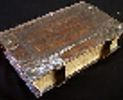
Image of Saint Margaret in a window
at St Margaret's Chapel, Edinburgh
Queen Margaret was a descendant of the Anglo-Saxon royalty that sought refuge during the Danish and Norman invasions of England. She was born in exile in Europe and educated there. She returned to England in 1057 at age 10. She grew up in the court of King Edward the Confessor with her brother (Edward's Heir). For some years a young prince, Malcolm III of Scotland also enjoyed the hospitality of the Confessor; he was sent to England for safety when his father Duncan was murdered by Macbeth. There he may have met Margaret, his future Queen.
When the Norman conquest in 1066 made her position intolerable, she fled England and a storm shipwreaked them on the coast of Scotland, they found a refuge in the court of Malcolm III. It was a wild age in Scotland, which had experianced a long series of viking invasions, frequent wars with England, and perpetual feuds between the native clans, which meant in spite of its Christianity, it was still really uncivilized.
Margaret was only 24 years old, beautiful, gentle and full of the spiritual virtues Malcolm knew a good thing when he saw it. He married her in 1070.
Margaret set about reforming the church in Scotland and introducing an English influence. Church life in Scotland was not strong at that time and there were those who were critical of the English influence Margaret brought to bear on the problem. Her husband, realizing her ability and her goodness, turned to her for advice about the affairs of the kingdom. Her biographer said that the king came to see 'that Christ truly dwelt in her heart. What she rejected, he rejected. What she loved, he, for love of her, loved too.'
She was a faithful wife and mother, bearing 6 sons and 2 daughters. She saw to the spiritual welfare of her large household and maintained a strong devotional life. She was famous for leading by example in her care for orphans and poor people, often visiting them in their homes and nursing them herself. She made herself freely available to anyone in trouble, and her care for the poor was well known. Intelligent and well-educated herself, she founded schools, hospitals and orphanages. She and her husband rebuilt the monastery of Iona, and built Dunfermline Abbey as a burial place for the Scottish royal family. In 1093 Malcolm was attacked and killed by William II of England, and Margaret herself died of an illness only 4 days later on 16 November, and was buried beside her husband at Dunfermline.
BORN: c. 1045,
Mecseknadas,
Hungary.
DIED: 16 November 1093,
Edinburgh Castle, Scotland.
 Welcome
Welcome Calendar
Calendar Today's Word
Today's Word Lauds
Lauds Terce
Terce Sext
Sext None
None Vespers
Vespers Compline
Compline Matins
Matins